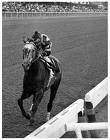A recent article by Clay Shirky (ht Seth's Blog), discusses the cognitive surplus society pisses away watching TV.
In the article, he writes about a professor in Brazil who started a Wiki page where locals can label exact locations of committed crimes. This community effort allows people to see, at a glance, where the more dangerous neighborhoods are, without having to wait for some bureaucratic process to get the ball rolling. The information is real time and relevant.
Seems like racing could use a similar system to track horse breakdowns at specific tracks and use that information, along with whatever isn't hidden or altered, to determine causal factors.
Getting honest reporting is another matter.
In The Science of Horse Training, Bill Pressey tirelessly fights the battle to bring a little science to the game. He posits a horse that can go a mile in under two minutes, with a heart rate below 200 beats per minute, possesses stakes calibre.
It would be interesting to see what his methods could produce from some legitimate race horses, at any level.
15 March 2010
Science and surplus
Subscribe to:
Post Comments (Atom)
The Bid

Greatest horse ever to look through a bridle





4 comments:
There are a few folks using heart monitors in training, more in Australia than here in the US, and those in the US mostly train off-track, as the economic pressures on-track are just horrendous -- too much pressure for exercise riders to jump off in a hurry and get on to the next horse. Apparently Aidan O'Brien at Coolmore is now using them as well, but, of course, he has all the money in the world behind him and trains off-track.
Hi Steve-
You are 100% exactly right.
They aren't too expensive, about $600 per rider - but its a part time job collecting and analyzing all of the data.
It's tough to get trainers to use them, but I have had some good success both in the US and abroad.
Lately the most interest has some from using the HR gear to assess yearling stock on the farm during the pre-sales conditioning process on the walk/jog wheels.
Luckily the economy has been so tough that farms are allowing behind the scenes access like never before in an effort to sell their stock.
I agree with Bill. A HR of less than 200 bpm at a steady speed of 800 m/min is an excellent starting point. However, at equinehealthfitness.com.au we like to also consider a horse's maximum HR, and of course we do not ignore its anaerobic sprint. The champions have it all - a huge cardiovascular capacity for oxygen transport, and the right mix of fast twitch muscle fibres to give them the 500-800 m dash.
The on-board GPS + HR can give all this information in a week of monitoring if the exercise tests are designed properly.
Cheers
David Evans
equinehealthfitness@gmail.com
re "It would be interesting to see what his methods could produce from some legitimate race horses, at any level."
There have been publications in the scientific literature outlining how these techniques can monitor fitness, and how measurements from HR and velocity on racetracks correlate with stakes earned (in Australia). Let me know if you would like details. We have adapted these published techniques for monitoring horses in thoroughbred stables on 4 continents.
Cheers
David Evans
equinehealthfitness@gmail.com
www.equinehealthfitness.com.au
Post a Comment